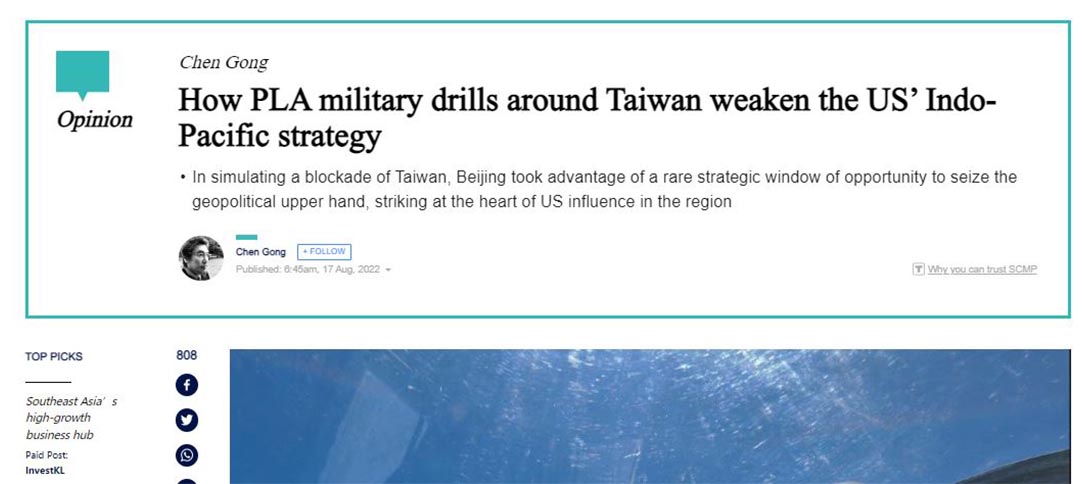
The People's Liberation Army said on August 10 it had concluded its largest exercises around Taiwan in decades, following US House Speaker Nancy Pelosi's visit to Taipei, and that it would continue regular combat readiness patrols in the Taiwan Strait.
From a geostrategic perspective, the exercises are a clear sign that a blockade of Taiwan has always been part of Beijing's plan to achieve unification.
Breaking the opponent's resistance without a fight and causing them to collapse on their own is an exceptional strategy, straight out of Sun Tzu's Art of War. This is certainly a superior and more pragmatic tactic than unification by using military force.
However, achieving this would require certain conditions, resources and windows of opportunity.
The Taiwan Strait is of high strategic significance, both for Beijing and others. It is a key route connecting Japan and South Korea to the global market. Meanwhile, more than 90 per cent of China's international goods trade is conducted by sea. Theoretically, there are four main strategic channels for China's maritime trade, most of which passes through the strait.
To create conditions for the control of Taiwan, China has long held that the strait falls within its territorial waters and exclusive economic zone. It recently clarified its position again. However, the US still intends to continue with freedom of navigation operations in the strait.
In addition, Washington has vigorously promoted an Indo-Pacific strategy, which includes countries like India, in the hope of building a broad alliance to undermine Beijing.
The PLA's military exercises around Taiwan, which started on August 4, came as a countermeasure. During joint air and sea exercises, bomber formations flew across the Taiwan Strait and long-range air strike capabilities were tested. In a show of force, missiles were fired into waters encircling Taiwan.
This is tantamount to installing gates around the island, which Beijing can open or close at will.
Such a blockade of Taiwan must have long been part of Beijing's strategy, but there have been few opportunities to put it into practice before this.
In future, should the need arise, Beijing could well increase the duration and intensity of the blockade, and deploy more firepower. If that happens, Taiwan might just have all the geopolitical significance of an inner island, or a peninsula controlled by mainland China.
The PLA's show of strength is in stark contrast to the US 7th Fleet's no-show, and seems to have diminished the significance of the Indo-Pacific strategy. During China's simulation of a blockade of Taiwan, while the US and its regional allies, including Japan and Australia, did protest, no concrete action was taken.
Geostrategy often comes down to windows, trends and dynamics. While Washington could respond to the situation created by Beijing during the military exercises, for now, China has seized the upper hand, and it will not be easy for the US to regain control.
Under such circumstances, Taiwan has been downplaying the impact of the military exercises. Taoyuan airport announced the cancellation of 51 flights for August 4, but denied that it was related to the PLA drills starting that day. Taipei said its crude oil reserves could last 146 days, and its natural gas reserves 11 days.
At the same time, Taiwan said it would work with Japan and the Philippines to find alternative aviation routes. Taiwan is an isolated island economy that relies on foreign trade and external linkages, hence any blockade would pose a big challenge.
In terms of international relations and geopolitics, this is an out-and-out offensive. The US will need to reflect, and begin to seriously consider retreating to the front line of Hawaii, and returning to its circle of power before the second world war.
Otherwise, Washington will have to weigh the actual impact of long-range strategic conflict. Is it really ready for that? For now at least, the Biden administration and the Taiwanese authorities seem unprepared.
With the PLA's military exercises, Beijing used a rare strategic window of opportunity to demonstrate a forceful geopolitical move that strikes Taiwan and weakens the US' Indo-Pacific strategy. The world has to rethink many issues.
Original Source:http://www.anbound.com/Section/ArticleView_30339_14.htm
